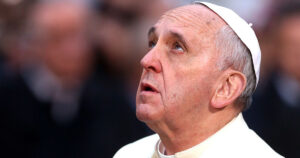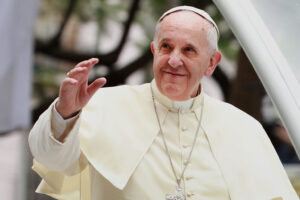
Pope Francis was admired for his humble lifestyle and simple way of living — but with his death, a series of ancient and almost mysterious rituals was suddenly set in motion.
One of the first? His apartment was sealed almost immediately — and the reason behind it is more intriguing than you might think.
Following Pope Francis’ passing on Monday, Catholics around the world are mourning the loss of their spiritual leader.
The Pope died of a stroke at the age of 88.
When a pope passes, a very precise and tradition-bound process is set in motion within the Vatican. For example, on Tuesday, the Vatican released the first powerful images of Pope Francis lying in repose, offering a solemn glimpse into the sacred rituals honoring his life.
In the photos, his open casket is surrounded by ceremonial guards as Vatican officials and members of his household gather to say their private goodbyes. Francis is dressed in red vestments — a color symbolizing martyrdom and the blood of Christ — with a rosary gently placed in his folded hands.
A silk cord tied across the door
Another event that followed the Pope’s death was the sealing and locking of Pope Francis’s personal residence by senior Vatican officials on Monday.
The sealing takes place immediately after the Pope has either passed away or resigned. It’s carried out in the presence of the Vice-Camerlengo — currently Archbishop Ilson de Jesus Montanari. A silk cord is tied across the door and secured with a wax seal, ensuring the room remains untouched. The unbroken seal serves as proof that no one has entered.

The room will only be opened again and the seal broken after the conclave is completed and a new Pope is elected.
According to CBS News, Pope Francis chose not to live in the traditional papal apartments of the Apostolic Palace. Instead, he made his home in a modest room at Casa Santa Marta — the Vatican’s guesthouse, which has more of a dorm-style setup.
“He lives in a small room,” said Lucas Schaerer, a Vatican insider who became friends with Pope Francis back in 2008, in a 2015 interview with People.
Why Pope’s apartment was sealed
So why was the Pope’s residence sealed off at all? While the ritual may seem largely symbolic—especially since Pope Francis chose to live in the simple quarters of the church guesthouse, Casa Santa Marta, rather than the traditional Apostolic Palace — it actually has a practical purpose as well.
According to Sky News, the practice originated as a way to “prevent looting” following a pope’s death.
But more importantly today, it helps safeguard against any tampering with papal documents or unauthorized release of items that can only be handled by the next pope. To ensure this, the sealing is carried out by a designated official of the Roman Curia — the Camerlengo, or Chamberlain — who is currently Cardinal Kevin Farrell, also head of the Vatican’s Dicastery for the Laity, Family, and Life.
Another ritual
As the Catholic Church moves forward with funeral arrangements and commemorative rites, attention has turned to the iconic Fisherman’s Ring that Pope Francis wore during his papacy.
Estimated to be worth approximately $520,000, the true significance of the ring lies far beyond its material value. As a symbol of the papacy, the signet ring represents the pope’s authority within the Catholic Church.

Traditionally, the ring is gifted to a newly elected pope and destroyed following their death. This ritual is carried out by the camerlengo (Cardinal), who, in this case, is Cardinal Kevin Farrell. The destruction serves to ensure that the ring cannot be misused after the pope’s death, as it was originally designed as a seal for the pope’s personal letters, though it now holds ceremonial importance.
The destruction of the ring and its accompanying bulla (papal seal) takes place in the presence of the College of Cardinals following official confirmation of the pope’s death, just before the papal conclave begins to elect a new pope.
The Vatican has confirmed that Pope Francis’ funeral will take place on Saturday, April 26 at 10 AM local time in St. Peter’s Square.
After the public ceremony, his body will be transported to the Basilica of Santa Maria Maggiore in Rome’s Esquilino neighborhood — the same place where Francis once said he wanted to be laid to rest.





